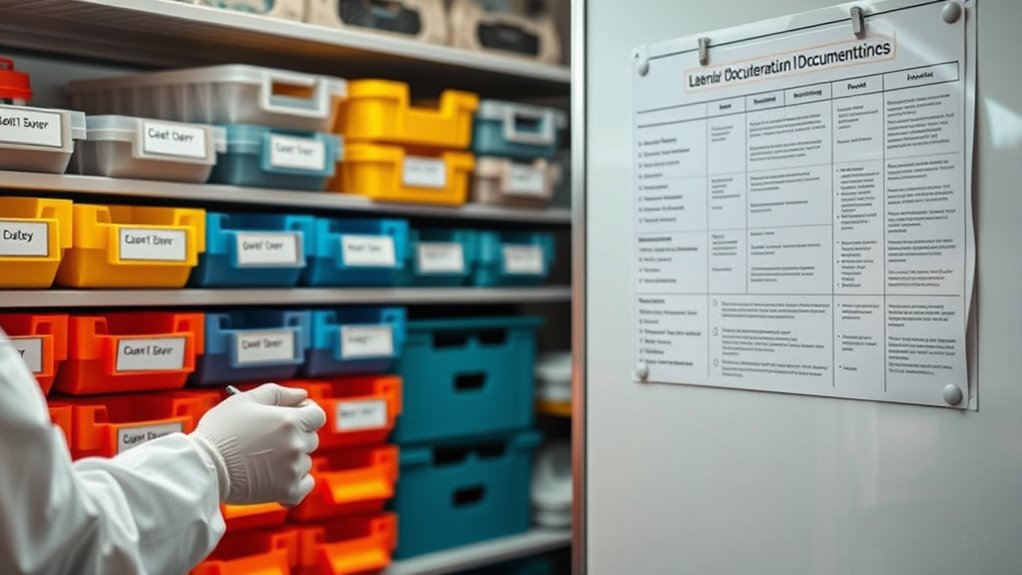Imagine walking into a cluttered workspace where labels are inconsistent and documentation is scattered. Without standardized practices, finding what you need becomes frustrating, and mistakes are more likely. By establishing clear labeling and thorough documentation, you can prevent confusion and improve efficiency. But how do you set up these systems effectively? Exploring best practices can help you create a structured environment that supports clarity, safety, and seamless operations.
Key Takeaways
- Establish clear, systematic naming conventions with descriptive terms, dates, and version identifiers for consistency.
- Document labeling standards and version control procedures to ensure team understanding and adherence.
- Use automation tools to enforce naming rules and automatically update version numbers or timestamps.
- Include detailed asset information in labels to facilitate quick identification and reduce errors.
- Maintain comprehensive documentation for asset history, update protocols, and compliance to support audits and quality control.

Effective labeling and documentation are indispensable for ensuring clarity, safety, and efficiency in any operation. When managing digital assets, proper labeling helps you quickly identify files, their purpose, and their status, reducing confusion and streamlining workflows. Clear labels serve as the first line of communication, guiding you through complex projects and large repositories. You want to avoid vague or inconsistent naming conventions, as they can lead to misfiled assets or duplicated efforts. Instead, adopt a systematic approach that includes descriptive terms, dates, versions, and relevant identifiers. This way, you can locate and verify assets with minimal effort, saving time and preventing costly mistakes.
Clear, systematic labeling streamlines digital asset management and prevents errors.
Digital asset management relies heavily on effective labeling to categorize and organize files. When assets are properly labeled, you gain better control over your digital library, enabling you to retrieve, share, and update assets efficiently. Consistent labeling standards ensure everyone on your team understands the naming conventions, fostering collaboration and reducing errors. Incorporating version control into your labeling process is equally crucial. Version control helps you track changes, maintain historical records, and prevent overwriting important updates. By including version numbers or timestamps in your labels, you make it easy to distinguish between different iterations of a file. This practice minimizes confusion and guarantees that everyone works from the most recent and accurate version.
Your documentation should detail your labeling conventions and version control procedures. This documentation acts as a reference guide, ensuring continuity even when team members change or new personnel join. It also promotes accountability and consistency across projects. When you implement structured documentation, you create a transparent environment where asset histories are clear, and updates are traceable. This transparency aids in audits, quality control, and compliance with industry standards.
Additionally, understanding pinball machine weight can be relevant when managing physical assets or installing equipment in different environments, emphasizing the importance of detailed records for both digital and physical assets. Furthermore, effective documentation includes instructions for updating labels and managing versions, so that your team knows exactly how to handle new assets or revisions. Automating parts of this process, such as using software that enforces naming conventions or automatically appends version numbers, can improve accuracy and save time. Remember, the goal is to remove ambiguity and make asset management intuitive. When everyone understands and follows your labeling and documentation practices, your operations become more reliable, faster, and less prone to errors.
Frequently Asked Questions
How Often Should Labeling and Documentation Be Reviewed?
You should review your labeling and documentation at least annually to guarantee accuracy and compliance. Regular review frequency helps catch outdated or incorrect information, prompting necessary documentation updates. If your environment changes frequently or regulations evolve, consider reviewing more often, such as quarterly. Staying proactive in your review process ensures your labels and documentation remain current, reducing errors and supporting smooth operations.
What Tools Are Best for Efficient Labeling Processes?
Perfect tools for your labeling process include automated labeling software and cloud storage solutions. Automated labeling accelerates accuracy, alleviating manual effort, while cloud storage guarantees secure, seamless access to your labeled data from anywhere. These tools team up to transform tedious tasks into efficient, effortless workflows. Embrace automation and cloud storage to elevate your labeling process, ensure consistency, and keep your data organized and accessible at all times.
How to Handle Outdated or Incorrect Labels?
When you encounter outdated or incorrect labels, promptly perform label revision to update the information. Use label verification to guarantee the new labels are accurate and clear. Regular audits help catch errors early, preventing confusion. Always document changes for traceability. This proactive approach keeps your labeling system reliable, ensuring consistency and compliance across all processes. Staying vigilant and systematic minimizes errors and maintains your documentation’s integrity.
Are There Industry-Specific Labeling Standards to Follow?
Sure, industry standards and compliance requirements are *just suggestions*, right? Wrong. You must follow specific labeling standards tailored to your industry—like OSHA for safety, FDA for food and drugs, or ISO for quality management. Ignoring these can lead to hefty fines or safety hazards. So, stay informed, adhere diligently, and remember: these standards aren’t optional; they’re your best defense against compliance mishaps.
How Can Digital Documentation Improve Labeling Accuracy?
Digital documentation improves labeling accuracy by reducing human error and enabling real-time updates. You can incorporate digital signatures to verify data authenticity, guaranteeing labels are trustworthy. Storing documents in cloud storage allows you to access the latest versions instantly, maintaining consistency across teams. With these tools, you streamline your labeling process, enhance accuracy, and ensure compliance, ultimately saving time and minimizing costly mistakes.
Conclusion
By adopting these labeling and documentation best practices, you’ll transform chaos into clarity. Think of it like organizing a library — when every book is properly labeled and cataloged, finding what you need becomes effortless. I once saw a team save hours simply by standardizing their asset labels, preventing costly mistakes. Clear, consistent labels aren’t just about organization; they’re the backbone of safety, efficiency, and peace of mind in your operations.









